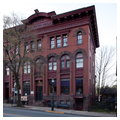This substantial Romanesque Revival building for the local branch of the Woman's Christian Temperance Union (WCTU) is constructed of red brick on a rusticated brownstone foundation. Seven fenestrated arched bays, each with prominent voussoirs, extend up the first two stories of the facade; the third story is punctuated by a row of narrow windows. The vertical emphasis of the bays is balanced by a massive projecting cornice, supported by muscular scroll bracketing. Italianate details include a large, central segmental-arched pediment and low relief decoration of festoons and wreaths on the frieze. Petrikin Hall illustrates the power and popularity of the WCTU, which by 1901 was one of the most prominent women's organizations in the country (see also AR13). Though later often dismissed as a rigid “bluestocking” organization, at the turn of the twentieth century, the WCTU embraced many progressive reform causes, including women's suffrage, and became an important political and cultural force. This WCTU building originally included a large public meeting room with apartments on the upper stories to provide rental income. When theaters and other venues proved too much competition, the building was given over to commercial and residential tenants.
You are here
WCTU Petrikin Hall
If SAH Archipedia has been useful to you, please consider supporting it.
SAH Archipedia tells the story of the United States through its buildings, landscapes, and cities. This freely available resource empowers the public with authoritative knowledge that deepens their understanding and appreciation of the built environment. But the Society of Architectural Historians, which created SAH Archipedia with University of Virginia Press, needs your support to maintain the high-caliber research, writing, photography, cartography, editing, design, and programming that make SAH Archipedia a trusted online resource available to all who value the history of place, heritage tourism, and learning.












